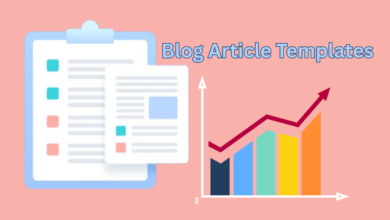Business Blogging Tips A Complete Guide to Boosting Your Brand Online

In today’s digital era, businesses need more than just a sleek website or social media presence to thrive. Blogging has become one of the most powerful tools for building authority, driving traffic, and nurturing relationships with customers. A well-structured business blog can elevate your brand, position you as an industry leader, and generate consistent leads. But to reap these benefits, you need the right business blogging tips.
This article will explore every aspect of business blogging, from strategy and content creation to SEO and promotion. Whether you’re a startup owner or managing a corporate marketing strategy, these insights will help you maximize the impact of your blogging efforts.
Why Business Blogging Matters
Business Blogging Tips is no longer a hobby; it’s a serious marketing strategy. For businesses, it serves several crucial purposes:
- Drives Organic Traffic – A blog optimized with the right keywords can attract visitors who are actively searching for solutions.
- Builds Authority – By sharing industry insights, case studies, and problem-solving content, your business becomes a trusted voice.
- Supports SEO – Each blog post provides an opportunity to rank for specific keywords.
- Generates Leads – Blogs can include calls-to-action (CTAs) to encourage readers to subscribe, download, or purchase.
- Strengthens Customer Relationships – Regular posting keeps your audience engaged and loyal.
These reasons alone make mastering business blogging tips a vital task for modern businesses.
Laying the Foundation: Before You Start Blogging
Define Your Goals
Before writing your first post, ask: What do I want my business blog to achieve? Possible goals include increasing brand awareness, improving SEO rankings, generating leads, or educating customers. Clear goals guide your blogging strategy.
Identify Your Target Audience
Understanding who you’re writing for is essential. Create buyer personas to visualize your ideal readers, their challenges, and their needs. Tailor content accordingly.
Choose the Right Blogging Platform
WordPress, HubSpot, and Wix are popular blogging platforms. WordPress, in particular, is widely favored for its flexibility, plugins, and SEO capabilities.
Essential Business Blogging Tips
H2: Plan Your Content Strategy
Consistency is key in blogging. Develop an editorial calendar to schedule posts, ensuring a steady stream of content. Mix educational articles, industry news, tutorials, and opinion pieces.
H3: Perform Keyword Research
Successful blogs are built on strong keyword strategies. Use tools like Google Keyword Planner, Ahrefs, or SEMrush to find terms your audience is searching for. For example, if your niche is digital marketing, target phrases like “content marketing tips” or “SEO strategies.”
H3: Focus on Evergreen Content
While trending topics bring short-term traffic, evergreen content provides long-term results. Examples include “How to Start a Business Blog” or “10 Best Business Blogging Tips.”
H2: Craft Compelling Content
H3: Write Catchy Headlines
Your headline is the first impression. Use power words, numbers, or questions to spark curiosity. For example: “10 Business Blogging Tips That Will Skyrocket Your Website Traffic.”
H3: Use a Conversational Tone
Avoid jargon-heavy language. Write as though you’re speaking to your reader directly. This builds trust and makes content easy to digest.
H3: Add Visuals and Multimedia
Images, infographics, and videos make your blog posts more engaging and shareable. Tools like Canva can help create professional graphics.
H2: Optimize for SEO
H3: On-Page SEO
- Use target keywords naturally in titles, subheadings, and throughout the article.
- Write meta descriptions that encourage clicks.
- Use internal and external links to improve authority.
H3: Optimize for Mobile and Speed
With mobile-first indexing, ensuring your blog loads quickly on smartphones is essential. Compress images and use caching plugins to improve speed.
H3: Schema Markup
Adding structured data helps search engines better understand your content, which can improve visibility in rich snippets.
H2: Promote Your Blog
H3: Leverage Social Media
Share your posts across LinkedIn, Twitter, Facebook, and Instagram. Tailor captions for each platform to maximize engagement.
H3: Use Email Marketing
Send newsletters with your latest blog posts. Subscribers are more likely to engage because they already trust your brand.
H3: Collaborate with Influencers
Guest posts, backlinks, or mentions from influencers in your industry can significantly expand your blog’s reach.
H2: Measure Success and Improve
H3: Track Analytics
Use Google Analytics or HubSpot to track metrics like page views, bounce rates, and conversion rates. This data reveals what works and what needs improvement.
H3: A/B Testing
Experiment with different blog titles, CTAs, or layouts. Testing helps refine strategies and improve results over time.
H3: Update Old Content
Don’t ignore older posts. Refresh outdated articles with new statistics, images, or keywords to maintain relevance.
Advanced Business Blogging Tips
- Create Pillar Content and Topic Clusters – Group related blogs under one broad topic for better SEO structure.
- Repurpose Content – Turn blogs into podcasts, videos, or LinkedIn posts to reach wider audiences.
- Encourage User-Generated Content – Invite guest authors or feature customer success stories.
- Invest in Professional Writing – High-quality writing reflects your brand’s professionalism and credibility.
- Leverage AI Tools – Tools like ChatGPT or Jasper can help brainstorm ideas or improve readability.
Common Mistakes to Avoid in Business Blogging
- Inconsistent Posting – Irregular updates reduce engagement.
- Overstuffing Keywords – This harms readability and SEO.
- Neglecting Promotion – Publishing without sharing is a wasted effort.
- Ignoring Reader Engagement – Responding to comments builds community and trust.
- Skipping Proofreading – Errors damage credibility.
By avoiding these pitfalls and applying the right business blogging tips, your blog can become a valuable asset.
FAQs on Business Blogging Tips
Q1: How often should I post on my business blog?
A: Consistency matters more than frequency. Aim for at least 1–2 posts per week, depending on your resources.
Q2: How long should a blog post be?
A: For SEO, long-form content (1,500–2,500 words) usually performs best. However, focus on delivering value rather than just word count.
Q3: Can a small business benefit from blogging?
A: Absolutely. Blogging helps small businesses build credibility, attract local traffic, and compete with larger brands.
Q4: Should I outsource business blogging?
A: If writing isn’t your strength or you lack time, outsourcing to professional writers or agencies ensures quality and consistency.
Q5: What is the most important business blogging tip for beginners?
A: Start with clear goals and focus on creating valuable, audience-driven content rather than chasing quick SEO wins.
Conclusion
Business blogging is more than just writing articles—it’s about strategy, consistency, and delivering real value to your audience. By applying these business blogging tips, you can transform your blog into a lead-generating, brand-building powerhouse. From keyword research and SEO optimization to promotion and analytics, every step counts.
Whether you’re a solo entrepreneur or managing a corporate marketing team, a strong business blog can set you apart in today’s competitive landscape. Start small, stay consistent, and keep refining your approach—the results will follow.



